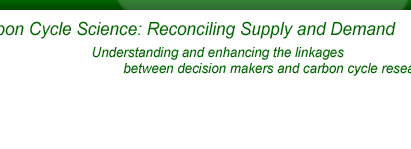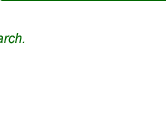 |
|
|
|
 |
|||||
|
|
|
|
|||||||
 |
|
|
|
|
|||||
 |
|||||||||
 |
|
|
|
|
Reconciling Supply and Demand
Workshop Summary
How might carbon cycle research under the US Global Change Research Program (i.e., the “supply” of carbon cycle science) more effectively and efficiently address the needs and capabilities of actual or potential decision makers who use carbon cycle science (i.e., the “demand” for carbon cycle science)?
In order to answer this question, we are “mapping” the production and use of carbon cycle science. We start by characterizing the needs of decision-makers and the supply of information from scientists and agencies, and then evaluate how well supply and demand is matched or unmatched (a “missed opportunity”). Finally we feed back to decision-makers both inside and outside the scientific and science agency communities in order to develop a process of “reconciling supply and demand”. Our goal is to contribute to the effectiveness of both carbon cycle research and decision making related to the carbon cycle.
On September 16-17, 2004 about 35 people convened for a workshop at the Natural Resource Ecology Laboratory in Fort Collins, Colorado to discuss reconciliation of supply of and demand (RSD) for carbon cycle science. Participants included carbon cycle scientists, program managers, social and policy scientists, people who make decisions implicated by carbon cycle science, as well as a number of graduate students. The workshop focused on characterizing supply, understanding demand, and learning lessons from other areas or research where RSD has been an important component of science policy (e.g., seasonal climate forecasting). The workshop focused closely on three cases in which to explore RSD in some detail: agro-ecosystems, the urban setting, and an international case study focused on the Large-Scale Biosphere Atmosphere Program in the Amazon. Six background papers were commissioned for the workshop focused on the methods and literature of RSD, a big-picture characterization and history of carbon cycle science, and on each of the case studies.
Among the outcomes of the workshop are the following:
- The metaphor of RSD provides a useful alternative to the “basic-applied-end use” linear model of science and decision-making and stimulated much discussion on the public usefulness of science, although its full robustness remains to be tested.
Key discussion points included: - Under the RSD model, how are demands characterized? Whose demands should be met? If demands are unstated, or not yet realized, how can they be brought to the table for action?
- If demands are being fully met by supply, but demands themselves are not representative of the fuller needs of a democratic society, how can this be addressed? How do equity concerns factor into the production of information and initial characterization of the supply and demand relationship? To what extent are scientists responsible for the use of their information?
- Can you objectively compare supply and demand when the reasons and motivation for information collection or needs are so different?
- The metaphor of reconciling supply and demand, while simple in concept, is potentially extremely complex in practice, as there are multiple possible users and multiple possible suppliers of information.
- It was clear that there were various definitions of what constitutes “carbon cycle science” within the scientific community and the broader user community. Most scientists settled on the notion of “global carbon cycle research” or smaller scale soil carbon research as clear examples of carbon cycle science, while users tended to discuss needs such as the need for local scale emissions inventories and factors, agricultural models suitable for commodity trading, or “solutions”-based research such as technology or local-scale options for reducing emissions.
- There were therefore significant examples from the case studies examined of the “mismatch” between supply and demand, as well as some areas of potentially well-matched activity. The areas of mismatch included, for example, the focus of the carbon cycle community represented at the workshop on global scale, natural carbon cycle science information as contrasted with the specific local needs of city managers or agricultural producer representatives. While the workshop was limited in scope (and therefore not able to represent the full range of either carbon cycle science or users), it was clear that many of the demands at the local scale were not being met. Even in the area of agricultural carbon sequestration, opinions differed on the usefulness of current research to the broader public. How this mismatch can be reconciled and whether the community assembled is the one to do it are open questions for further research. As one participant commented, at the local scale, “the best measurement unit is not spatial [meaning geographic], it is “agency space.” What is important [to characterize] is what can be influenced by local decision-making”. Areas where supply and demand were more closely linked included the policy arena, where it was felt that supplying additional information on large-scale carbon sinks might be contributing to international policy negotiations. The exact details of this match though were not fully explored in the limited time of the workshop.
- We can therefore hypothesize that carbon cycle science has the potential to meet a range of demands (and needs, etc.) of decision makers in a very wide range of decision contexts, e.g., individual, local, municipal, corporate, regional, national, and international. Carbon cycle science has significant opportunity to focus more robustly on these demands; it is currently focused on a very small subset.
- In the context of international climate policy specifically, which comprises a significant rationale for much of current carbon cycle science, the carbon cycle science community has an unrealized opportunity to contribute to policy analysis and evaluation, e.g., in the example of separation of management versus natural impacts on the carbon cycle and implications of carbon science on policy options. Current priorities of carbon programs assume that information will be relevant to policy, but direct links between research priorities and policy needs were not evident. Certainly at a meta-level, information on carbon budgets and so forth was discussed as relevant to negotiations, but when details of policy proposals emerged, such as quantifying separation, it was clear that carbon cycle science would need to be much more closely focused to meet some of those objectives. Whether or not such a research direction is appropriate was discussed, several participants disagreed on the degree to which certain policies merited further investment of research and what the role of carbon cycle scientists should be.
- NOAA and other agencies that support carbon cycle research have a range of options at their disposal to improve the connections of carbon cycle science and those decision makers who use (or might use) carbon cycle science in their processes of decision making, including ........ The agencies are critical brokers of the interface between supply and demand, as they set priorities and decide what research meets designated outcomes.
- Suggestions for moving forward the reconciliation of supply and demand for carbon cycle science in those areas of “missed opportunity” included understanding how decisions are made that may involve carbon cycle science, developing designated translators, or brokers between the two streams, supporting boundary organizations, and increasing the use of knowledge from areas not traditionally considered scientific literature such as city inventories, case studies, etc. The process of reconciliation requires a mediated interface between the supply and demand sides, i.e., it is not sufficient to have the supply side and the demand side simply communicate (e.g., through end user surveys). There are a wide range of methods and models for the creation of “boundary organizations” to mediate the interface of supply and demand. Such options give carbon cycle program managers considerably flexibility for taking practical steps to improve the reconciliation of supply and demand.
- Some of the barriers to reconciling supply and demand of carbon cycle science discussed by participants include the scientific culture and reward system, agency mission and procedures, timescale disconnects between research and policy processes, and lack of experience in facilitating this interface. While there is some experience in crafting the scientist-user interface in the area of water resource management, climate forecasting, etc., this is a very new area for most carbon cycle scientists and funding agencies.
- While not all carbon cycle science is expected to meet the broader needs of society, there is certainly an opportunity for more of it to do so than is currently the case. Decisions on carbon management, carbon sequestration, and energy strategies have the potential to be supported by data and information as necessary. A next step following from this workshop would be to develop practical options for carbon cycle science policies focused on developing processes, programs, and mechanisms to facilitate the reconciliation of supply of and demand for carbon cycle science. These options would need to be tested and developed in concert with the scientific community, stakeholders, and carbon cycle science policy makers. We will also need to do a fuller characterization of research programs underway in carbon sequestration, where they may be a much more developed connection to users.